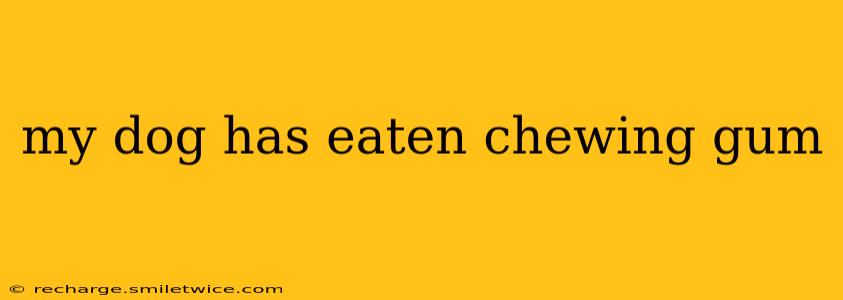Finding out your dog has eaten chewing gum can be incredibly stressful. Chewing gum, especially sugar-free varieties, contains ingredients that can be toxic to dogs. This guide will walk you through the immediate steps to take and help you understand the potential risks and long-term effects.
What's the Big Deal About Chewing Gum?
The primary concern with dogs ingesting chewing gum isn't the gum base itself, but rather the sweeteners it often contains. Many sugar-free gums use xylitol, a sugar alcohol that's incredibly toxic to dogs. Even small amounts can cause a rapid drop in blood sugar (hypoglycemia), leading to weakness, seizures, and even liver failure in severe cases. Other artificial sweeteners can also pose risks, although generally less severe than xylitol.
How Much Gum Did Your Dog Eat?
Determining the amount of gum ingested is crucial. Was it a small piece, or a whole pack? Knowing the type of gum (specifically, if it contains xylitol) is equally important. This information is essential for guiding your next steps.
What are the Symptoms of Xylitol Poisoning in Dogs?
Symptoms typically appear within 30 minutes to 12 hours of ingestion and can include:
- Vomiting: This is one of the first signs and can be accompanied by diarrhea.
- Weakness and lethargy: Your dog may appear unusually tired or unsteady on its feet.
- Tremors and seizures: These are serious symptoms requiring immediate veterinary attention.
- Loss of coordination: Difficulty walking or standing.
- Difficulty breathing: This is a life-threatening symptom.
- Liver failure (in severe cases): This can manifest later and requires extensive veterinary care.
My Dog Ate Chewing Gum: What Should I Do?
1. Immediate Action:
- Identify the gum: Check the packaging for ingredients, specifically looking for xylitol.
- Contact your veterinarian or an animal poison control center immediately: Don't delay. Time is critical, especially if xylitol is involved. The ASPCA Animal Poison Control Center (APCC) and the Pet Poison Helpline are valuable resources. They can provide guidance based on the specific circumstances.
- Do NOT induce vomiting unless instructed by a veterinarian: Improperly inducing vomiting can cause more harm than good.
2. Gathering Information:
- How much gum was eaten? Be as accurate as possible.
- What type of gum was it? Include the brand name and any ingredient information.
- When did the ingestion occur?
- What are your dog's current symptoms?
3. Following Veterinary Instructions:
Your vet will provide specific instructions based on your dog's situation. This might include inducing vomiting, administering activated charcoal, or providing supportive care like intravenous fluids. Follow their guidance carefully.
What if My Dog Only Ate a Small Amount of Gum Without Xylitol?
Even if the gum doesn't contain xylitol, it's still wise to monitor your dog closely. Watch for any signs of digestive upset like vomiting or diarrhea. If these symptoms worsen or persist, contact your veterinarian.
Can I Prevent My Dog From Eating Chewing Gum in the Future?
- Securely store chewing gum: Keep gum out of reach and preferably in a sealed container.
- Train your dog: Teach your dog commands like "leave it" and "drop it."
- Supervise your dog: Always supervise your dog, especially around potential hazards.
This information is for educational purposes only and should not replace professional veterinary advice. Always contact your veterinarian or an animal poison control center if you suspect your dog has ingested something potentially harmful. Their expertise is crucial for ensuring your dog's well-being.
